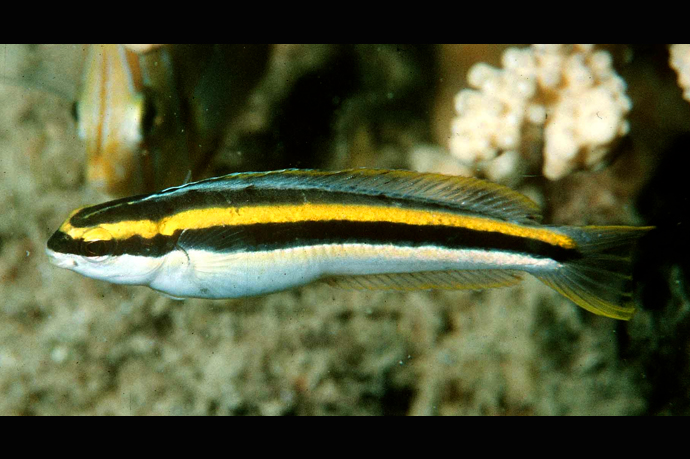Yellow Fangblenny, Meiacanthus luteus Smith Vaniz 1987
Other Names: Gold-stripe Harptail Blenny

A female Yellow Fangblenny, Meiacanthus luteus, at Keppel Island, Queensland. Source: Rudie H. Kuiter / Aquatic Photographics. License: All rights reserved
Summary:
A fangblenny with a bright yellow stripe running along the upperside bordered by a dark brown to black midlateral stripe and a dusky to dark brown stripe along the upper back that does not extend onto the dorsal-fin base, and broad yellow margins on the dorsal, anal, and upper and lower lobes of the caudal fin.
Blennies of the genus Meiacanthus have grooved lower jaw canines with associated venom glands.
Blennies of the genus Meiacanthus have grooved lower jaw canines with associated venom glands.
Cite this page as:
Bray, D.J. 2021, Meiacanthus luteus in Fishes of Australia, accessed 01 Jul 2025, https://fishesofaustralia.net.au/Home/species/1074
Yellow Fangblenny, Meiacanthus luteus Smith Vaniz 1987
More Info
|
Distribution |
Endemic to northern Australia from the Exmouth Gulf, Western Australia, to east of Elliot Heads, southern Great Barrier Reef, Queensland. Inhabits coastal and offshore reefs, sometimes in turbid areas, at depths to 100m. A Yellow Fangblenny was filmed by BRUVs (baited remote underwater video) at a depth of 100m on the outer Great Barrier Reef (Sih et al. 2017). |
|
Features |
Dorsal fin IV, 26-27; Anal fin II, 15-18; Pectoral fin 15-16. Males have elongate pelvic fins and caudal-fin lobes. |
|
Colour |
A white blenny with a dark brown to black midlateral stripe running from the snout tip through the eye to the caudal-fin base, a dusky to dark brown stripe from above the eye running along the dorsal-fin base, with bright yellow coloration on the head and body between the two stripes. |
|
Fisheries |
Meiacanthus blennies have grooved dentary canines with associated buccal glands containing a toxin. These poisonous canines provide considerable protection from predators allowing them to feed over a wide area including in the water column. |
|
Etymology |
The specific name luteus means 'yellow' in reference to the brilliant upper body colouration of this species. |
|
Species Citation |
Meiacanthus (Meiacanthus) luteus Smith-Vaniz, 1987, Proc. Acad. Nat. Sci., Philad. 139: 25, figs 14d-f, 18a. Type locality: Darwin Harbour, Northern Territory. |
|
Author |
Bray, D.J. 2021 |
|
Resources |
Yellow Fangblenny, Meiacanthus luteus Smith Vaniz 1987
References
Allen, G.R. 1997. Marine Fishes of Tropical Australia and South-east Asia. Perth : Western Australian Museum 292 pp. 106 pls.
Kuiter, R.H. 1996. Guide to Sea Fishes of Australia. A comprehensive reference for divers and fishermen. Sydney, NSW, Australia : New Holland Publishers xvii, 434 pp.
Larson, H.K. & Williams, R.S. 1997. Darwin Harbour fishes: a survey and annotated checklist. pp. 339-380 in Hanley, H.R., Caswell, G., Megirian, D. & Larson, H.K. (eds). The Marine Flora and Fauna of Darwin Harbour, Northern Territory, Australia. Proceedings of the Sixth International Marine Biology Workshop. Darwin : Museum and Art Gallery of the Northern Territory 466 pp.
Larson, H.K., Williams, R.S. & Hammer, M.P. 2013. An annotated checklist of the fishes of the Northern Territory, Australia. Zootaxa 3696(1): 1-293
Randall, J.E., Allen, G.R. & Steene, R. 1990. Fishes of the Great Barrier Reef and Coral Sea. Bathurst : Crawford House Press 507 pp. figs.
Randall, J.E., Allen, G.R. & Steene, R. 1997. Fishes of the Great Barrier Reef and Coral Sea. Bathurst : Crawford House Press 557 pp. figs.
Sih, T.L., Cappo, M. & Kingsford, M. 2017. Deep-reef fish assemblages of the Great Barrier Reef shelf-break (Australia). Scientific Reports 7(1): 10886. https://doi.org/10.1038/s41598-017-11452-1
Smith-Vaniz, W.F. 1976. The saber-toothed blennies, Tribe Nemophini (Pisces: Bleniidae). Academy of Natural Sciences of Philadelphia Monographs 19: 196 pp.
Smith-Vaniz, W.F. 1987. The saber-toothed blennies, tribe Nemophini (Pisces: Bleniidae): an update. Proceedings of the Academy of Natural Sciences of Philadelphia 139: 1-52 https://www.jstor.org/stable/4064893
Smith-Vaniz, W.F. & Allen, G.R. 2011. Three new species of the fangblenny genus Meiacanthus from Indonesia, with color photographs and comments on other species (Teleostei: Blenniidae: Nemophini). Zootaxa 3046: 39-58. http://dx.doi.org/10.11646/zootaxa.3046.1.2
Smith-Vaniz, W.F. & Allen, G.R. 2019. Meiacanthus solomon, a new fangblenny (Teleostei: Blenniidae) from the Solomon Islands, with a redescription and new records of M. limbatus. Journal of the Ocean Science Foundation 33: 44-52. https://doi.org/10.5281/zenodo.3268872
Smith-Vaniz, W. F., Satapoomin, U. & Allen, G.R. 2001. Meiacanthus urostigma, a new fangblenny from the northeastern Indian Ocean, with discussion and examples of mimicry in species of Meiacanthus (Teleostei: Blenniidae: Nemophini). aqua, Journal of Ichthyology and Aquatic Biology 5(1): 25-43 See ref online
Springer, V.G. 2001. Blenniidae. pp. 3538-3546 in Carpenter, K.E. & Niem, T.H. (eds). The Living Marine Resources of the Western Central Pacific. FAO Species Identification Guide for Fisheries Purposes. Rome : FAO Vol. 6 pp. 3381-4218.



